 W
WA stairway, staircase, stairwell, flight of stairs, or simply stairs, is a construction designed to bridge a large vertical distance by dividing it into smaller vertical distances, called steps. Stairs may be straight, round, or may consist of two or more straight pieces connected at angles.
 W
WThe list of ancient spiral stairs contains a selection of Greco-Roman spiral stairs constructed during classical antiquity. The spiral stair is a type of stairway which, due to its complex helical structure, has been introduced relatively late into architecture. Although the oldest example dates back to the 5th century BC, it was only in the wake of the influential design of the Trajan's Column that this space-saving new type permanently caught hold in ancient Roman architecture.
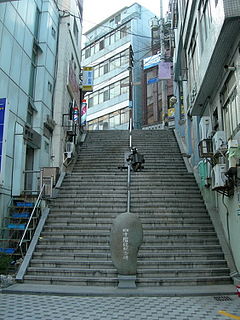 W
WThe 40–step stairway is a historic stairway in the Jung District of Busan, South Korea. It sits at one end of the 40-step Culture & Tourism Theme Street, which is a tourist attraction intended to recall the history of the area and in particular its importance to refugees during and after the Korean War. The staircase itself was known as a common location for refugees to seek reunification with their families and friends, given the lack of functional communications during the War. The 40–step stairway appears in the film Nowhere to Hide.
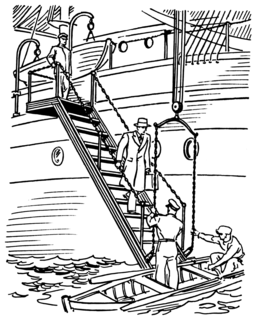 W
WAn accommodation ladder is a portable flight of steps down a ship's side.
 W
WAn airstair is a set of steps built into an aircraft so that passengers may board and alight the aircraft. The stairs are often built into a clamshell-style door on the aircraft. Airstairs eliminate the need for passengers to use a mobile stairway or jetway to board or exit the aircraft, providing more independence from ground services. Some of the earliest aircraft to feature airstairs were the Martin 2-0-2 and Martin 4-0-4. Some models of the Douglas DC-3 were also retrofitted with airstairs. As airport infrastructure has developed, the need for airstairs has decreased, as jetways or mobile stairways are often available.
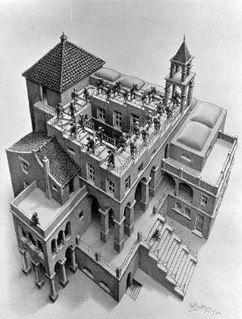 W
WAscending and Descending is a lithograph print by the Dutch artist M. C. Escher first printed in March 1960.
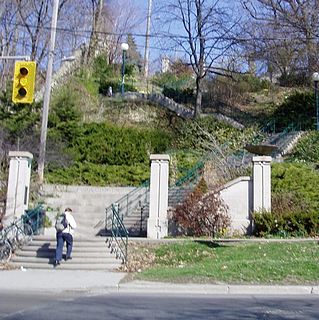 W
WThe Baldwin Steps are a public outdoor staircase located in Toronto, Ontario, Canada dating from the 19th century. The Steps, which are constructed of stone and concrete, transcend a steep escarpment marking an ancient shoreline. The steps are named after the Baldwin family, which included Robert Baldwin, a former premier of Ontario, whose family were the first landowners. The Steps are also famous for appearing in the Scott Pilgrim graphic novels and its film adaptation, Scott Pilgrim vs. the World.
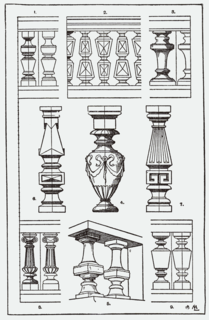 W
WA baluster is a vertical moulded shaft, square, or lathe-turned form found in stairways, parapets, and other architectural features. In furniture construction it is known as a spindle. Common materials used in its construction are wood, stone, and less frequently metal and ceramic. A group of balusters supporting handrail, coping, or ornamental detail are known as a balustrade.
 W
WA handrail is a rail that is designed to be grasped by the hand so as to provide stability or support. Handrails are commonly used while ascending or descending stairways and escalators in order to prevent injurious falls. Handrails are typically supported by posts or mounted directly to walls.
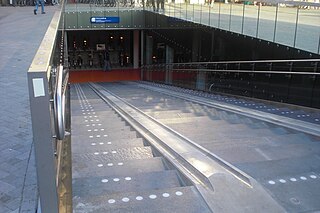 W
WA bicycle stairway is a pedestrian stairway which also has a channel alongside it to facilitate walking a bicycle up or down the stairway.
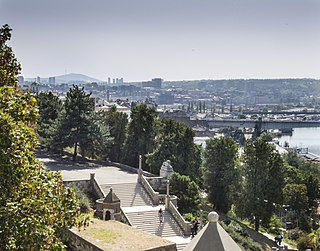 W
WThe Big Staircase in Kalemegdan Park is the most monumental park motive in Kalemegdan Park. It occupies the area in the southwest frontline of the fortress, on the location of the former rampart and a hidden road.
 W
WQuartier du Petit Champlain is a small commercial zone in Quebec City, Quebec, Canada. It is located in the neighbourhood of Vieux-Québec–Cap-Blanc–colline Parlementaire in the borough of La Cité-Limoilou, near Place Royale and its Notre-Dame-des-Victoires Church. Its main street is the Rue du Petit-Champlain at the foot of Cap Diamant. It is claimed that it's the oldest commercial district in North America.
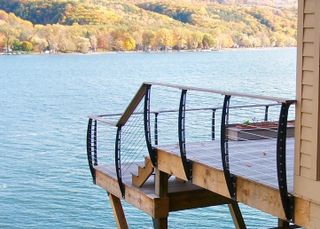 W
WCable railings, or wire rope railings, are safety rails that use horizontal or vertical cables in place of spindles, glass and mesh for infill.
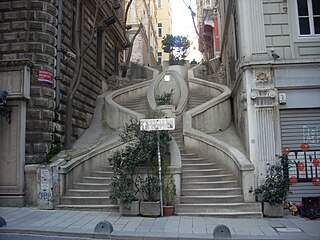 W
WThe Camondo family was a prominent European family of Jewish financiers and philanthropists.
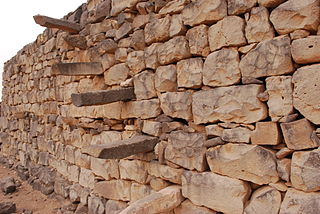 W
WCantilevered stairs, or floating stairs, are a type of staircase.
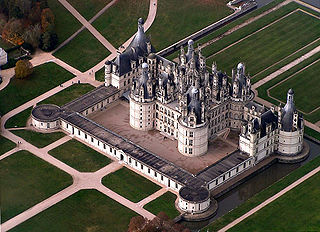 W
WThe Château de Chambord in Chambord, Centre Region, France, is one of the most recognisable châteaux in the world because of its very distinctive French Renaissance architecture which blends traditional French medieval forms with classical Renaissance structures. The building, which was never completed, was constructed by Francis I.
 W
WThe Chkalov Stairs is a monumental flight of steps in the center of Nizhny Novgorod, connecting Minin and Pozharsky Square, the Upper Volga and the Lower Volga embankments. It was built by the architects Alexander Yakovlev, Lev Rudnev and Vladimir Munts. It is the longest staircase in Russia. The staircase starts from the monument to Chkalov, near the St. George's Tower of the Kremlin. It is built in the form of a figure of eight and consists of 560 steps, if you count it both sides. The number of steps from the bottom to the top is 442 on the right. In the intersections of the side slopes there are two observation platforms. At the bottom of the stairs is a monument to the boat "Hero", which is located at the Lower-Volga embankment.
 W
WA stairway, staircase, stairwell, flight of stairs, or simply stairs, is a construction designed to bridge a large vertical distance by dividing it into smaller vertical distances, called steps. Stairs may be straight, round, or may consist of two or more straight pieces connected at angles.
 W
WThe CN Tower is a 553.3 m-high (1,815.3 ft) concrete communications and observation tower located in Downtown Toronto, Ontario, Canada. Built on the former Railway Lands, it was completed in 1976. Its name "CN" originally referred to Canadian National, the railway company that built the tower. Following the railway's decision to divest non-core freight railway assets prior to the company's privatization in 1995, it transferred the tower to the Canada Lands Company, a federal Crown corporation responsible for real estate development.
 W
WThe Cumberland Place and Steps are heritage-listed steps and a laneway located at Cumberland Place, in the inner city Sydney suburb of The Rocks in the City of Sydney local government area of New South Wales, Australia. It was built from 1807. It is also known as Suffolk Lane; Stubbs Lane; Gloucester Lane; and Cribb's Lane. The property is owned by Property NSW, an agency of the Government of New South Wales. It was added to the New South Wales State Heritage Register on 10 May 2002.
 W
WThe Depaldo Stone Steps was constructed in 1823 by the project of the Italian architect Francesco Boffo with the money of Taganrog's Greek merchant Gerasim Depaldo at the crossroads of Greek Street and Depaldo Street in Taganrog. The stairway begins up on the hill in downtown and goes down ending near Azov seashore.
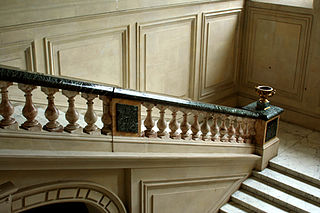 W
WA dog-leg is a configuration of stairs between two floors of a building, often a domestic building, in which a flight of stairs ascends to a half-landing before turning at a right angle and continuing upwards. The flights do not have to be equal, and frequently are not.
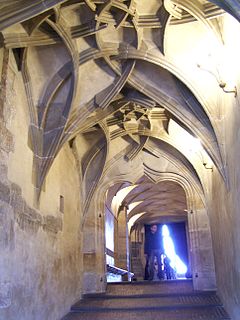 W
WAn equestrian staircase or riders' staircase is a very gently sloping flight of steps that can be negotiated by horses. Its origins may be seen in the mule staircases in steep terrain in open country.
 W
WEscadaria Selarón, also known as the 'Selaron Steps', is a set of world-famous steps in Rio de Janeiro, Brazil. They are the work of Chilean-born artist Jorge Selarón who claimed it as "my tribute to the Brazilian people".
 W
WAn escalator is a moving staircase which carries people between floors of a building. It consists of a motor-driven chain of individually linked steps on a track which cycle on a pair of tracks which keep them horizontal.
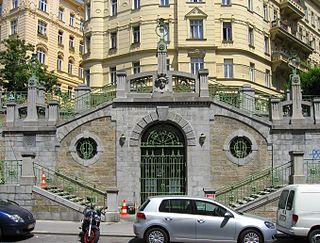 W
WThe Fillgraderstiege is a staircase in the sixth district of Vienna, Mariahilf. It was built from 1905 to 1907 and designed by Max Hegele, a student of Victor Luntz and Carl Hasenauer, in an Art Nouveau style to connect the two streets, Fillgradergasse and Theobaldgasse.
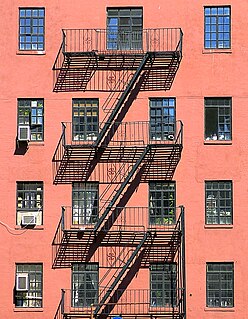 W
WA fire escape is a special kind of emergency exit, usually mounted to the outside of a building or occasionally inside but separate from the main areas of the building. It provides a method of escape in the event of a fire or other emergency that makes the stairwells inside a building inaccessible. Fire escapes are most often found on multiple-story residential buildings, such as apartment buildings. At one time, they were a very important aspect of fire safety for all new construction in urban areas; more recently, however, they have fallen out of common use. This is due to the improved building codes incorporating fire detectors, technologically advanced fire fighting equipment, which includes better communications and the reach of fire fighting ladder trucks, and more importantly fire sprinklers. The international building codes and other authoritative agencies have incorporated fire sprinklers into multi-story buildings below 15 storeys and not just skyscrapers.
 W
WThe Gemonian Stairs were a flight of steps located in the ancient city of Rome. Nicknamed the Stairs of Mourning, the stairs are infamous in Roman history as a place of execution.
 W
WThe Gibson Steps are an area of cliffs on the south coast of Australia, located at 38°40′06″S 143°06′43″E. The cliffs are the first sightseeing stopoff in Port Campbell National Park for travellers heading West along the Great Ocean Road, located about 2 minutes drive from The Twelve Apostles. The name Gibson Steps refers to the staircase leading down to the stretch of beach shown to the right.
 W
WA handrail is a rail that is designed to be grasped by the hand so as to provide stability or support. Handrails are commonly used while ascending or descending stairways and escalators in order to prevent injurious falls. Handrails are typically supported by posts or mounted directly to walls.
 W
WAn imperial staircase is the name given to a staircase with divided flights. Usually the first flight rises to a half-landing and then divides into two symmetrical flights both rising with an equal number of steps and turns to the next floor. The feature is reputed to have first been used at El Escorial. One of the grandest examples, the Escalier des Ambassadeurs at the Palace of Versailles, was built by 1680 but demolished in 1752 as the palace was rearranged. The Jordan Staircase of the Winter Palace is a notable example, while other such staircases can be found at Buckingham Palace, Windsor Castle, Palazzo Reale di Caserta, Palacio Real de Madrid and Mentmore Towers.
 W
WJacob's Ladder is a Grade I-listed staircase leading from Jamestown, Saint Helena, up the side of Ladder Hill to Ladder Hill Fort.
 W
WThe principal or Jordan Staircase of the Winter Palace, St Petersburg is so called because on the Feast of the Epiphany the Tsar descended this imperial staircase in state for the ceremony of the "Blessing of the Waters" of the Neva River, a celebration of Christ's baptism in the Jordan River. The staircase is one of the few parts of the palace retaining the original 18th-century style. The massive grey granite columns, however, were added in the mid 19th century.
 W
WKelly's Steps is an architectural landmark in Hobart, Tasmania. The steps, named after early Australian explorer and whaler James Kelly, connect the suburb of Battery Point to Salamanca Place. At the time Kelly constructed the steps in 1839, Battery Point was on a cliff that overlooked wharfs of Sullivans Cove. The steps were cut into the stone of the cliffs. The warehouses that lined the wharfs on what is now Salamanca Place were built with stone quarried from the cliffs. The steps lead up to Kelly Street, Battery Point. At the foot of the steps, Kelly's Lane leads to Salamanca Place.
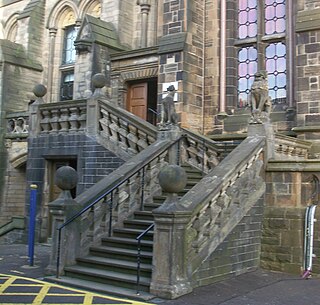 W
WThe Lion and Unicorn Staircase, at the University of Glasgow, is located next to the University's Memorial Chapel on the west side of the Main Building. It consists of two flights connected by a landing, the upper flight turning ninety degrees to the left from the lower flight. There is a balustrade adorned with sculptures of a unicorn on the left and a lion on the right. Along with the Memorial Chapel and the adjacent Gilbert Scott Building, it is protected as a Category A listed building.
 W
WThe Mayflower Steps are close to the site in the Barbican area of Plymouth, south-west England, from which the Pilgrim Fathers are believed to have finally left England aboard the Mayflower on 6 September 1620, before crossing the Atlantic Ocean to settle in North America. The traditional site of their disembarkation in North America is Plymouth Rock.
 W
WMontagne de Bueren is a 374-step staircase in Liège, Belgium. The staircase is named after Vincent de Bueren, who defended Liège against an attack by the Duke of Burgundy, Charles the Bold in the 15th century. It was built in 1881 to honour the 600 soldiers who died in the battle.
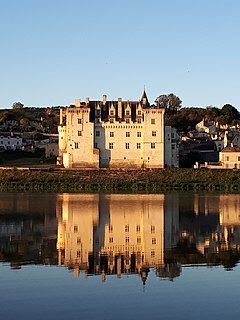 W
WThe Château de Montsoreau is a Renaissance style castle in the Loire Valley, directly built in the Loire riverbed. It is located in the small market town of Montsoreau, in the Maine-et-Loire département of France, close to Saumur, Chinon, Fontevraud-L'abbaye and Candes-Saint-Martin. The Château de Montsoreau has an exceptional position at the confluence of two rivers, the Loire and the Vienne, and at the meeting point of three historic regions: Anjou, Poitou and Touraine. It is the only château of the Loire Valley to have been built directly in the Loire riverbed.
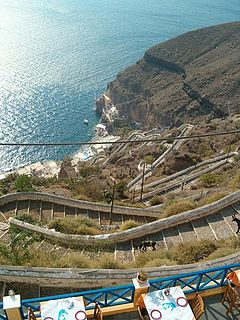 W
WA mule ramp, or horse ramp, is a very gently sloping ramp that can be negotiated by pack animals. Originally, mule ramps were used in steep terrain in the open countryside. They usually have steps.
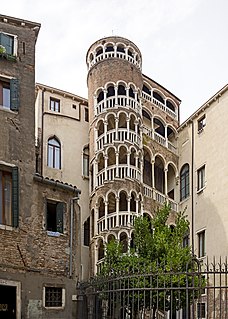 W
WThe Palazzo Contarini del Bovolo is a small palazzo in Venice, Italy, best known for its external multi-arch spiral staircase known as the Scala Contarini del Bovolo.
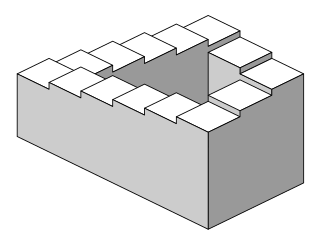 W
WThe Penrose stairs or Penrose steps, also dubbed the impossible staircase, is an impossible object created by Oscar Reutersvärd in 1937 and later made popular by Lionel Penrose and his son Roger Penrose. A variation on the Penrose triangle, it is a two-dimensional depiction of a staircase in which the stairs make four 90-degree turns as they ascend or descend yet form a continuous loop, so that a person could climb them forever and never get any higher. This is clearly impossible in three-dimensional Euclidean geometry.
 W
WIn architecture, a perron generally refers to an external stairway to a building. Curl notes three more-specific usages: the platform-landing reached by symmetrical flights of steps leading to the piano nobile of a building; the steps themselves; or the platform base of edifices like a market cross. Perron also refers to a type of Belgian civic monument, which usually sits on a perron.
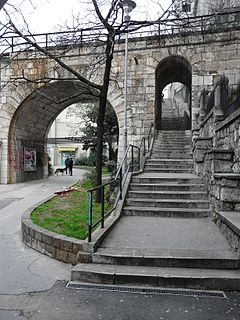 W
WPetar Kružić stairway, or Petar Kružić staircase, or Trsat stairway is the stone stairway in Rijeka (Croatia) that leads from Rijeka to Trsat.
 W
WThe Potemkin Stairs, or Potemkin Steps, is a giant stairway in Odessa, Ukraine. The stairs are considered a formal entrance into the city from the direction of the sea and are the best known symbol of Odessa. The stairs were originally known as the Boulevard steps, the Giant Staircase, or the Richelieu steps. The top step is 12.5 meters wide, and the lowest step is 21.7 meters wide. The staircase extends for 142 meters, but it gives the illusion of greater length. Due to the sightline, a person looking down the stairs sees only the treads, and the risers are invisible; whereas a person looking up sees only risers, and the treads are invisible.
 W
WA stair riser is the near-vertical element in a set of stairs, forming the space between one step and the next. It is sometimes slightly inclined from the vertical so that its top is closer than its base to the person climbing the stairs. The horizontal edge of the stair is called the nosing, whereas the surface on which a person's whole foot makes contact is called the tread.
 W
WThe Scala Sancta are a set of 28 white marble steps that are Roman Catholic relics located in an edifice on extraterritorial property of the Holy See in Rome, Italy proximate to the Archbasilica of Saint John in Laterano. Officially, the edifice is titled the Pontifical Sanctuary of the Holy Stairs, and incorporates part of the old Papal Lateran Palace. Replica stairs flank the original staircase, which may only be climbed on one's knees. The Holy Stairs lead to the Church of Saint Lawrence in Palatio ad Sancta Sanctorum or simply the "Sancta Sanctorum", which was the personal chapel of the early Popes.
 W
WSchroeder stairs is an optical illusion which is a two-dimensional drawing which may be perceived either as a drawing of a staircase leading from left to right downwards or the same staircase only turned upside down, a classical example of perspective reversal in psychology of perception. It is named after the German natural scientist Heinrich G. F. Schröder, who published it in 1858.
 W
WThe Giant's Causeway is an area of about 40,000 interlocking basalt columns, the result of an ancient volcanic fissure eruption. It is located in County Antrim on the north coast of Northern Ireland, about three miles (4.8 km) northeast of the town of Bushmills.
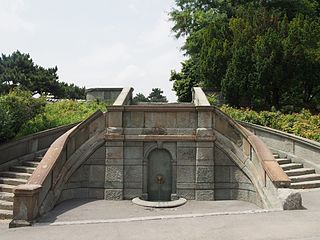 W
WThe Small Staircase in Kalemegdan Park is a staircase at one of the entrances into Kalemegdan Park in downtown Belgrade, Serbia. It is a representative of the park architecture and integral part of the park's promenade above the Sava river. It is part of the Belgrade Fortress complex, which is placed under the state protection as the Cultural Monuments of Exceptional Importance and the staircase itself is described as having both the architectural-urban and the cultural-historical values.
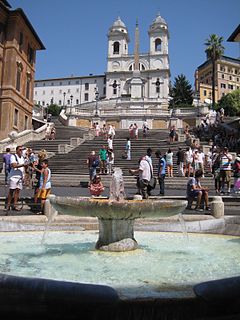 W
WThe Spanish Steps are a set of steps in Rome, Italy, climbing a steep slope between the Piazza di Spagna at the base and Piazza Trinità dei Monti, dominated by the Trinità dei Monti church at the top.
 W
WStair climbing is the climbing of a flight of stairs. It is often described as a "low-impact" exercise, often for people who have recently started trying to get in shape. A common exhortation in health pop culture is "Take the stairs, not the elevator".
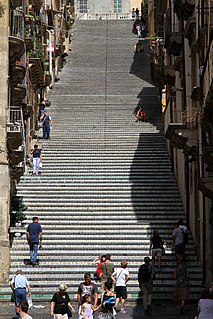 W
WScalinata di Santa Maria del Monte is a set of world-famous steps in Caltagirone, Sicily, Italy. It was built in 1606 in order to connect the ancient part of Caltagirone to the new city built in the upper part. The staircase, over 130 meters (430 ft) long, is flanked by balcony buildings and is today one of the identifying monuments of the city.
 W
WA staircase tower or stair tower is a tower-like wing of a building with a circular or polygonal plan that contains a stairwell, usually a helical staircase.
 W
WA stair lift is a mechanical device for lifting people, typically those with disabilities, up and down stairs. For sufficiently wide stairs, a rail is mounted to the treads of the stairs. A chair or lifting platform is attached to the rail. A person gets onto the chair or platform and is lifted up or down the stairs by the chair which moves along the rail.
 W
WThe Strudlhofstiege is an outdoor staircase of architectural and literary significance in Vienna, Austria. Located in the Alsergrund district, it is named after a former art school run by the painter Peter Strudel.
 W
WTiger and Turtle – Magic Mountain is an art installation and landmark in Angerpark, Duisburg, Germany, built in 2011. It was designed by Ulrich Genth and Heike Mutter. It resembles a roller coaster, but it is a walkway with stairs. Its vertical loop continues the walkway and stairs, but it is unwalkable and is blocked off. In 2013, Tiger and Turtle – Magic Mountain was ranked as #6 on HuffPost's list of Most Extreme Staircases.
 W
WThe set of large ornate staircases in the first-class section of the RMS Titanic, sometimes collectively referred to as the Grand Staircase, is one of the most recognizable features of the British transatlantic ocean liner which sank on her maiden voyage in 1912 after a collision with an iceberg. Reflecting and reinforcing the staircase's iconic status is its frequent, and prominent, portrayal in media.
 W
WThe Victoria Arches are a series of bricked-up arches built in an embankment of the River Irwell in Manchester. They served as business premises, landing stages for steam packet riverboats and as Second World War air-raid shelters. They were accessed from wooden staircases that descended from Victoria Street.
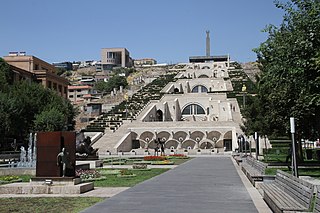 W
WThe Cascade is a giant stairway made of limestone in Yerevan, Armenia. It links the downtown Kentron area of Yerevan with the Monument neighborhood. Designed by architects Jim Torosyan, Aslan Mkhitaryan, and Sargis Gurzadyan the construction of the cascade started in 1971 and was partially completed in 1980.